


Notice: This is the official website of the All Empires History Community (Reg. 10 Feb 2002)
Chinese Art, 2000 BC - 1800 AD |
Post Reply 
|
Page <1234> |
| Author | |
Preobrazhenskoe 
Consul 
Joined: 27-Jul-2006 Location: United States Online Status: Offline Posts: 398 |
 Quote Quote  Reply Reply
 Topic: Chinese Art, 2000 BC - 1800 AD Topic: Chinese Art, 2000 BC - 1800 ADPosted: 26-Oct-2006 at 23:17 |
|
Eastern Zhou Dynasty, bronze Ritual Vessel (Fang Hu), 5th century BC http://img221.imageshack.us/my.php?image=e...stybronzit8.jpg Eastern Jin Dynasty, Deqing Ware Ewer, stoneware, 4th-5th century http://img209.imageshack.us/my.php?image=e...tydeqingbj6.jpg Eastern Zhou Dynasty, bronze bell (yong zhong), 6th century BC http://img120.imageshack.us/my.php?image=e...stybronzhz7.jpg Yuan Dynasty, lacquer on wood box, late 13th century http://img209.imageshack.us/my.php?image=y...ueronwoouq0.jpg Ming Dynasty, Box with cover, lacquer over wood, Wanli Reign (1573-1620) http://img120.imageshack.us/my.php?image=m...ithcoverxx9.jpg Northern Song Dynasty, jade hound, 10th-11th century http://img221.imageshack.us/my.php?image=n...astyjadeno1.jpg Neolithic Period, jade cong, circa 2000 BC http://img101.imageshack.us/my.php?image=n...jadecongvy4.jpg Qing Dynasty, lacquer box over wood, Qianlong reign (1736-1795) http://img221.imageshack.us/my.php?image=q...uerboxovxl2.jpg Spring Landscape, by Ma Wan, 1343 AD http://img120.imageshack.us/my.php?image=s...bymawan1yj3.jpg Song Dynasty jade vessel with elephant lugs, 12th-13th century http://img120.imageshack.us/my.php?image=s...vesselwiro1.jpg Eric |
|
 |
|
jiangweibaoye 
Consul 
Joined: 25-Mar-2005 Location: United States Online Status: Offline Posts: 360 |
 Quote Quote  Reply Reply
 Posted: 27-Oct-2006 at 12:12 Posted: 27-Oct-2006 at 12:12 |
|
Guys,
This is a wonderful thread you guys started.
I will try to contribute some pictures (I am sure you have them already) probably when the market closes.
Jiangwei
|
|
 |
|
Hellios 
Arch Duke 

Joined: 25-Sep-2006 Location: Canada Online Status: Offline Posts: 1933 |
 Quote Quote  Reply Reply
 Posted: 27-Oct-2006 at 14:32 Posted: 27-Oct-2006 at 14:32 |
|
Eric, since which dynasty have the Chinese been making those beautiful lanterns? Here's a few from the Chinese Garden gallery:
   "The use of decorative lanterns to brighten and illuminate Chinese festivities is said to date back to the Han dynasty (206 B.C.B220 A.D.), while the tradition of stringing up lanterns on the 15th day of the first lunar month was supposedly born during the Sui dynasty (581B618). It was during the Tang dynasty (618-907) that common people began using lanterns to mark the end of the New Year's celebration--a practice that had previously been an Imperial prerogative."
Rgds/Bill
Edited by Hellios - 27-Oct-2006 at 15:01 |
|
 |
|
Siege Tower 
Colonel 

Joined: 28-Aug-2006 Location: Edmonton,Canada Online Status: Offline Posts: 580 |
 Quote Quote  Reply Reply
 Posted: 27-Oct-2006 at 15:36 Posted: 27-Oct-2006 at 15:36 |
|
you are definately, a few days ago, there was a Chinese Lattern Festival in Toronto, i was amused
|
|
 |
|
Preobrazhenskoe 
Consul 
Joined: 27-Jul-2006 Location: United States Online Status: Offline Posts: 398 |
 Quote Quote  Reply Reply
 Posted: 28-Oct-2006 at 18:29 Posted: 28-Oct-2006 at 18:29 |
|
From this site here: http://www.chinatownhi.com/lanterns.asp, it would seem to contradict the quote you posted above, Hellios, about the origins of the Chinese-style lantern during the Han Dynasty. Apparently, it went back a little farther than that, during the late Warring States Period, although back then it would have been out of other materials besides paper, since paper was an invention in China since the early 2nd century with the court eunuch known as Cai Lun.
"Originating as far back as 250 B.C., the basic Chinese lantern has remained unchanged in design. The sleeve or frame that surrounds the candle is assembled from pliable bamboo, sturdy redwood or inexpensive wire. To soften the harsh light of a naked flame, thin or oiled paper, gauze or silk fabric covers the frame to create the familiar flattering, soft glow. In contrast to the simplicity of the standard spherical lantern, the zouma deng lantern was designed during the Song dynasty (960-1279), an era of innovation that included developments in type printing, gunpowder and paper currency. The zouma deng resembles a miniature pavilion with upturned eaves. An inner wire shaft is fitted with paper vanes, and the heat current generated from the flame rotates the shaft, setting a paper cutout in a charming merry-go-round motion, hence the name, since zouma deng means "roundabout."
The lantern played an important role in military communications, particularly when the Chinese Empire was divided into three warring kingdoms. The Chinese historical tome Romance of the Three Kingdoms, set during the Han dynasty (206 B.C.�A.D. 220), describes how the respected military strategist and war hero Zhuge Liang (nicknamed Kung Ming) made a special lantern designed to alert neighboring ally cities of approaching attack or danger. A strip of kerosene-soused cloth or paper was ignited and placed inside a lamp that floated upward into the night sky. In times of peace, the size and elevation of lanterns hanging outside houses indicated social status in Chinese society. To show off wealth, Chinese elite hung lanterns made of silk velvet from second-floor balconies and verandas. Lanterns belonging to the rich were so large that they required several men with poles to hang them. At the onset of the Cultural Revolution, the lantern, like many other Chinese arts, was deemed ourgeois and banned for the next decade. But visitors today will find a voluminous array of once-forbidden lanterns located above Chairman Mao�s portrait on Tiananmen Tower."
 Eric Edited by Preobrazhenskoe - 28-Oct-2006 at 18:31 |
|
 |
|
Preobrazhenskoe 
Consul 
Joined: 27-Jul-2006 Location: United States Online Status: Offline Posts: 398 |
 Quote Quote  Reply Reply
 Posted: 30-Oct-2006 at 17:36 Posted: 30-Oct-2006 at 17:36 |
|
The earliest surviving examples of Chinese paintings we have are from the Warring States Period (481-221 BC) and Han Dynasty (202 BC - 220 AD) painted on silk or tomb murals painted on rock, brick, and stone. However, the earliest of these paintings during the late Zhou period were rudimentary, 2 dimensional scenes of mythical creatures and people drawn in the same continual, stylized format, nothing like the people and creatures depicted in the same time period on the intricate 3 dimensional art of ancient Shang and Zhou Dynasty bronze-wares, jade carvings, and the enormous Terracotta Army assembled in life-like men and horses for the tomb of the First Qin Emperor (died in 210 BC). In the ancient Shang, Zhou, Qin, and Han Dynasties, the functions of art were often reserved for purposes of geomancy, funerary rights, representation of the mythological deities and ancestor spirits, in other words, mythological and religious in intent and practice. The First Qin Emperor truly believed that the 8,099 Terracotta men and horses he had thousands working to craft and labor on would serve to guard him in the afterlife.
Warring States painting on silk of a man riding a dragon, Chu State tomb, 5th-3rd century BC:  Western Han Dynasty (202 BC - 8 AD) Silk Banner found in the tomb at Mawangdui 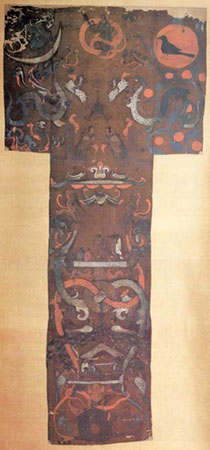 An example of Han Dynasty murals: 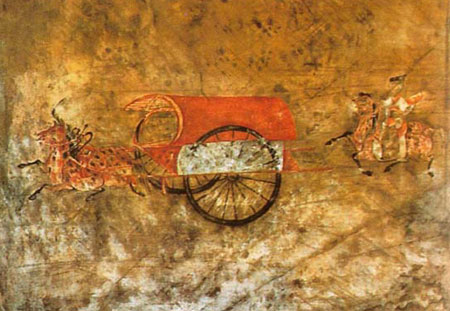 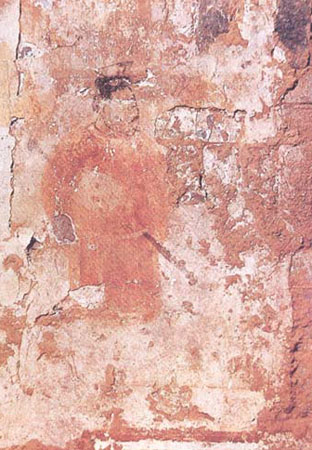 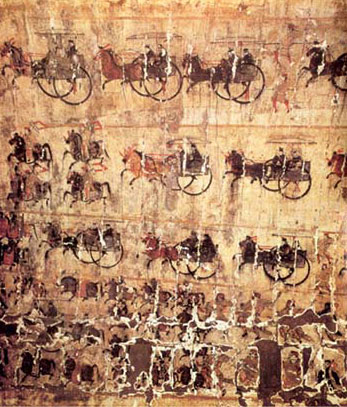 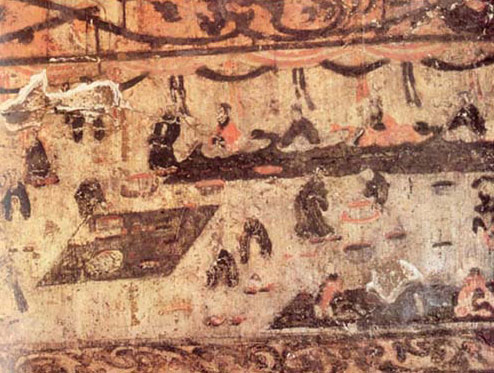 Tomb murals of horse-riders on a hunt and outing, Wei Dynasty (220-265 AD) 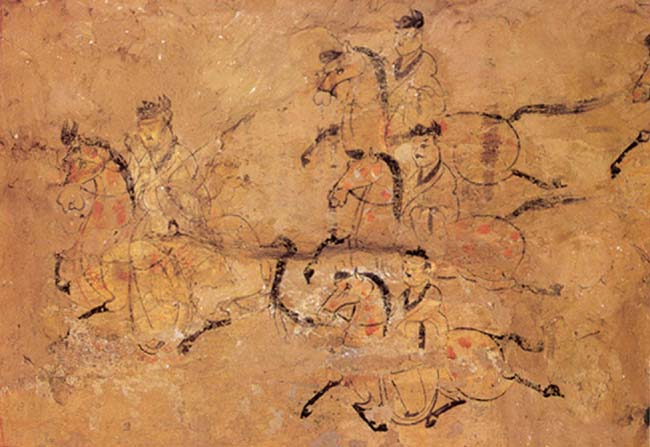 Even after the papermaking process was innovated by Cai Lun of the Eastern Han Dynasty (2nd century), paper wasn't necessarily the material of choice for exquisite paintings (although printed materials from the 9th century onwards on paper would feature inked artwork), as silk scrolls remained the prevalent method for those to express themselves through art. During the Wei and Western Jin Dynasties, mural paintings and painted decorations on silk became gradually more complex, but the real revolution in Chinese art (along with the introduction of professional landscape art) came during the Northern and Southern Dynasties Period (317-581 AD). It was during the early 4th century that the once centrally unifying Western Jin state was threatened and then defeated by oncoming northern steppe nomads known as the Xiongnu, who sacked the capital at Luoyang and forced the Jin court to flee south to establish their control over the southern half of China, establishing the Eastern Jin Dynasty (317-420 AD) at Jiankang (modern-day Nanjing). While culture in the north became a hybrid Chinese/northern nomadic fusion (the military ranks even drawn up opon the standards of nomadic cavalry units), the southern dynasties saw their own cultural flourishing apart from the northerners. It was here at Jiankang (Nanjing) where the social norms and accepted practices/pasttimes of a proper Confucian literati were developed and implemented. The most important sophisticated pasttimes of an upright Confucian scholar or bureaucrat became established as: 1. Writing and reciting poetry 2. Playing the musical instrument of the guqin (ancient Chinese stringed-zither) 4. Writing through fancy calligraphy 3. Painting, whether it be landscape, portrait, etc. Poetry became so emphasized in Chinese society during the Tang Dynasty, that it was actually made one of the required fields of study to master if one wanted to pass the rigid Civil Service and Imperial Exams in order to become a government official. However, for the purposes of this thread, I'll stick to painting. With a greater emphasis on painting came greater social expectations for one to achieve greater and more sophisticated artistic heights than their contemporaries, and especially their Han predecessors who were avid tomb mural and silken dress/banners/scroll painters. Arguably the greatest artistic painter during this time was the court official for the Eastern Jin known as Gu Kaizhi, who painted his first painting in Nanjing in 364 AD, at the age of 20. Gu Kaizhi was not only popular in his own time, but was revered by later artists who used him and his art as the prime example of matured Chinese art. Gu Kaizhi once wrote, "In figure paintings the clothes and the appearances were not very important. The eyes were the spirit and the decisive factor." Landscape Artwork and Admonitions of the Instructress to the Court Ladies originally painted by the Eastern Jin Dynasty master of art, Gu Kaizhi (lived 344-406 AD) 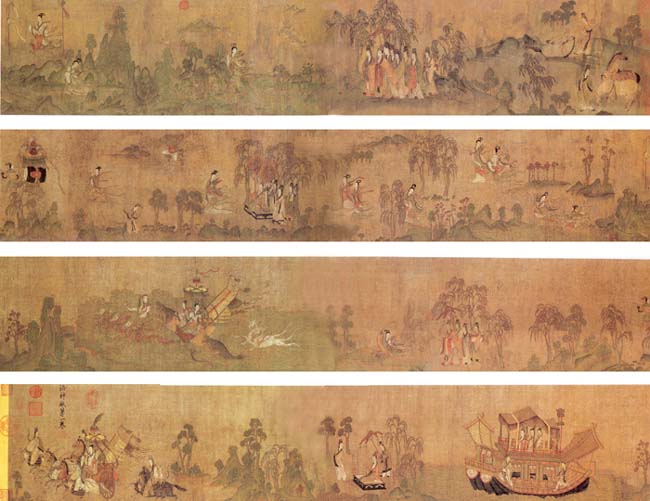 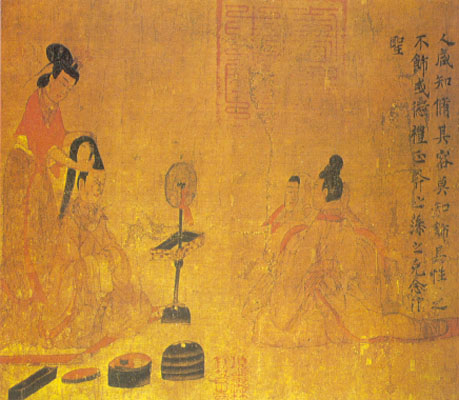 Eric Edited by Preobrazhenskoe - 30-Oct-2006 at 22:25 |
|
 |
|
Preobrazhenskoe 
Consul 
Joined: 27-Jul-2006 Location: United States Online Status: Offline Posts: 398 |
 Quote Quote  Reply Reply
 Posted: 30-Oct-2006 at 20:34 Posted: 30-Oct-2006 at 20:34 |
 The Yangzi River, 13th century, Southern Song Dynasty era http://img212.imageshack.us/my.php?image=t...3thcentupd1.jpg  A Bodhisattva and Two Attendants, Yuan Dynasty (1279-1368) http://img212.imageshack.us/my.php?image=a...twoattengf4.jpg  A Lohan and His Attendant, Ming Dynasty (1368-1644) http://img212.imageshack.us/my.php?image=a...endantmidr8.jpg  Birds and Plum Blossoms, Ming Dynasty (1368-1644) http://img212.imageshack.us/my.php?image=b...ssomsminvh4.jpg  A Black and Smoke-Gray Horse, 18th century, Qing Dynasty http://img242.imageshack.us/my.php?image=a...ryqingdyus1.jpg  Tang Dynasty Bronze Mirror, 8th century http://img218.imageshack.us/my.php?image=t...zemirrorce0.jpg  Coromandel screen, wood painting, 1672 AD http://img206.imageshack.us/my.php?image=c...nwoodpaiza0.jpg  Northern Song Dynasty, Guanyin on a Rocky Edge, marble stele, Emperor Zhezong Reign, 1091 AD http://img223.imageshack.us/my.php?image=e...eignguanwz5.jpg  Eastern Zhou Dynasty Belt Hook, pure jade, 4th century BC http://img179.imageshack.us/my.php?image=e...stybelthub0.jpg  Southern Song Dynasty Mallet Shaped Vase, stoneware with Guan-type glaze, 12th century http://img223.imageshack.us/my.php?image=s...astymallbj9.jpg Eric |
|
 |
|
flyingzone 
Caliph 
Joined: 11-Dec-2005 Online Status: Offline Posts: 2630 |
 Quote Quote  Reply Reply
 Posted: 30-Oct-2006 at 22:16 Posted: 30-Oct-2006 at 22:16 |
|
Eric, you seem to be quite an expert on Chinese art. I want to ask you a question that maybe quite a few of us who know little about Chinese art would like to ask - Can you tell the difference between the different styles and different periods of, say, Chinese painting?
I came across the following article which raised (and then answered) the same question. If you have time, could you take a look at it and tell me what you think?
|
|
 |
|
Preobrazhenskoe 
Consul 
Joined: 27-Jul-2006 Location: United States Online Status: Offline Posts: 398 |
 Quote Quote  Reply Reply
 Posted: 30-Oct-2006 at 22:45 Posted: 30-Oct-2006 at 22:45 |
|
Wow, I actually learned quite a bit just from reading that. Thanks for the Serbian guy's treatise on Chinese art, flyingzone, it was pretty informative. As to telling the difference between different styles/time periods for Chinese paintings, it's easy to tell apart a Qing era painting from a Tang Dynasty painting (people's clothes from time era, arrangement of items in a painted scene, the stylized format, the choice of certain items to paint, richness in detail, etc.) and sometimes it is very hard to tell the difference (unless both are weathered and worn somehow at the same rate). Many Chinese painters made so many remakes of the masterpieces of earlier masters, it's hard for some to tell the difference between the two, unless you have the aid of an artistic professional at your side to guide you. I am not the latter, although I do know a bit about the art of Chinese painting. Eric
|
|
 |
|
Preobrazhenskoe 
Consul 
Joined: 27-Jul-2006 Location: United States Online Status: Offline Posts: 398 |
 Quote Quote  Reply Reply
 Posted: 01-Nov-2006 at 16:43 Posted: 01-Nov-2006 at 16:43 |
|
Buddhist Divinity, Attendants, Musicians, and Dancer, mid 14th century, late Yuan or early Ming Dynasty Yueyang Pavilion, by Xia Yong, mid 14th century, late Yuan or early Ming Dynasty Scroll Painting, A Palace Between Lake and Mountains, Ming Dynasty (1368-1644) Geese Beneath the Moon, 15th century Ming Dynasty The Goddess Chang'e in the Lunar Palace, original by Zhou Wenju, 16th century A Mother, Child, and Three Maids, Qing Dynasty (1644-1911) Cornice of Funerary Couch, limestone, 550 - 577 AD Northern Song Dynasty Ewer, porcelain qingbai glaze, 11th century Southern Song Dynasty Vase, glazed stoneware guan-type, 12th century Eastern Zhou Dynasty Ceremonial Stemmed Oval Cup, lacquer-ware, 5th-4th century BC Eric |
|
 |
|
Qin Dynasty 
Shogun 
Joined: 08-Jan-2006 Location: China Online Status: Offline Posts: 211 |
 Quote Quote  Reply Reply
 Posted: 03-Nov-2006 at 07:47 Posted: 03-Nov-2006 at 07:47 |
|
i have seen the real Qing MIng festival on the river in Shanghai Muesum along with other hundreds paintings. It was a periodic tour exhibition held by the Palace muesum. The Qing MIng festival and a painting painted by a Song emperor impressed me a lot. Partly because it took me 3hours queuing for the 5 minutes to see them. The real painting is small than i ve expected, but really delicate. Pity is that i ve only got a glance at the painting the crowds after me pushing me out of the gallery.
|
|
 |
|
Preobrazhenskoe 
Consul 
Joined: 27-Jul-2006 Location: United States Online Status: Offline Posts: 398 |
 Quote Quote  Reply Reply
 Posted: 03-Nov-2006 at 14:38 Posted: 03-Nov-2006 at 14:38 |
|
Awesome, Qin Dynasty! I wish I could see it first-hand myself, although the half-hour-long wait for a 5 minute viewing would be somewhat of a downer. :( Still, a great piece of art.
Eric
|
|
 |
|
Preobrazhenskoe 
Consul 
Joined: 27-Jul-2006 Location: United States Online Status: Offline Posts: 398 |
 Quote Quote  Reply Reply
 Posted: 07-Nov-2006 at 18:17 Posted: 07-Nov-2006 at 18:17 |
|
A Tartar, an Emaciated Horse, and Dog, Yuan Dynasty (1279-1368 AD) A Tartar, an Emaciated Horse, and Dog, Ming Dynasty remake (1368-1644 AD) A Luohan and an Attendant, painting on silk, mid-14th century Yuan or Ming Dynasty Autumn Foilage in a Mountain Gorge, Ming Dynasty (1368-1644 AD) Late Eastern Zhou Dynasty Pendants, nephrite (jade) and gold, early 3rd century BC Liao Dynasty Vase, earthenware with lead-silicate glaze, c. 907-1125 AD Grooming an Elephant, by Cui Zihong (died in 1644 AD), late Ming Dynasty Ming Dynasty Porcelain Bowl, Xuande Reign, 1426-1435 AD Southern Song Dynasty Longquan Vase, 1200-1279 AD Tang Dynasty Silver-Gilt Bowl, early 8th century AD Eric |
|
 |
|
Preobrazhenskoe 
Consul 
Joined: 27-Jul-2006 Location: United States Online Status: Offline Posts: 398 |
 Quote Quote  Reply Reply
 Posted: 08-Nov-2006 at 01:12 Posted: 08-Nov-2006 at 01:12 |
|
Eastern Zhou Dynasty, ritual wine container (hu), 8th century BC Eastern Zhou Dynasty, ritual wine vessel, bronze, gold, and silver, 6th-5th century BC Tang Dynasty, jade-carved figure of a plump foreign traveler, 7th century AD Northern Song Dynasty, Longquan type ware, stoneware, circa 960-1000 AD Ming Dynasty, Guanyin Figurine, ivory, early 17th century Yuan Dynasty, porcelain dish, early-to-mid 14th century Ming Dynasty, lacquer over wood cup and stand, Yongle Reign (1403-1424) Ming Dynasty, portrait of Father Zhang Jimin and Mother Zhao, early 17th century Zhong Kui Patrolling the Palace, by Hongwu (active 1751-1792) Qing Dynasty, Cloisonne Stupa, metal, enamel, gilt, Qianlong Emperor's reign era (1735-1796) Eric |
|
 |
|
Preobrazhenskoe 
Consul 
Joined: 27-Jul-2006 Location: United States Online Status: Offline Posts: 398 |
 Quote Quote  Reply Reply
 Posted: 12-Nov-2006 at 17:18 Posted: 12-Nov-2006 at 17:18 |
|
Luohan and a Demon, painting on silk scroll, Yuan Dynasty (1279-1368 AD) Tang Dynasty Amphora, white stoneware colorless glaze, 7th century Eastern Zhou Dynasty Jade Lady Ornament, 5th-4th centuries BC Ming Dynasty Porcelain Bowl with decoration of scholar officials, circa 1450-1500 AD Northern Song Dynasty, Cizhou Ware Jar, 11th century AD Ming Dynasty Yixing Ware Teapot, stoneware, 16th century Visitor on a Boat, 15th century Ming Dynasty Northern Wei Dynasty Bodhisattva, carved sandstone, circa 525 AD Tang Dynasty Silver Cup with Cover, 9th century Portrait of a Man and His Servant, mid 17th century, Ming or Qing Dynasty transitional period Eric |
|
 |
|
Hellios 
Arch Duke 

Joined: 25-Sep-2006 Location: Canada Online Status: Offline Posts: 1933 |
 Quote Quote  Reply Reply
 Posted: 01-Dec-2006 at 04:41 Posted: 01-Dec-2006 at 04:41 |
|
Eric, heard about this?
"A Chinese ceramic bowl from the 18th century sold for $19.42 million US at an auction in Hong Kong on Tuesday, breaking the world record price for Qing Dynasty ceramics, Christie's auction house said.
The famille rose Guyuexuan bowl bears the seal of the Qianlong Emperor, who reigned from 1736 to 1795.
It is the most expensive work of art ever sold in an Asian auction, Christie's said."
 Rgds, Bill
|
|
 |
|
Siege Tower 
Colonel 

Joined: 28-Aug-2006 Location: Edmonton,Canada Online Status: Offline Posts: 580 |
 Quote Quote  Reply Reply
 Posted: 01-Dec-2006 at 12:23 Posted: 01-Dec-2006 at 12:23 |
|
it is true, Qing & ming ceramic bowl s are quiet valuable, especially the Qing ceramic bowl.
|
|
 |
|
Preobrazhenskoe 
Consul 
Joined: 27-Jul-2006 Location: United States Online Status: Offline Posts: 398 |
 Quote Quote  Reply Reply
 Posted: 01-Dec-2006 at 12:41 Posted: 01-Dec-2006 at 12:41 |
Holy crap man! 19 million dollars!? Besides the fact of this guy being able to sling money around like that, I wonder if this guy has actually seen other genuine porcelain items from the Qianlong era, as I've even posted some here. I'm sorry, but the enameling on that bowl, and the overall design, are of a lesser quality than a good amount of Qianlong-era porcelain wares I've seen. Period. It's really not that exquisite, to be honest...heck, the Charles Lang Freer gallery porcelain items blow that out of the water. If I was that guy, even with that kind of money, I wouldn't have paid more than $5-7 million for it. But no more, cuz it just wouldn't be worth it (unless the money was going to a charity or something nice like that, which is often the case with auctions like this). Is Christie's auction house a major charity provider? Eric |
|
 |
|
The Charioteer 
Colonel 
Joined: 16-Feb-2006 Online Status: Offline Posts: 735 |
 Quote Quote  Reply Reply
 Posted: 01-Dec-2006 at 17:10 Posted: 01-Dec-2006 at 17:10 |
|
"Spring Festival (Qing Ming) on the River, this is an 18th century remake of an 11th century classic by Zhang Zerui"
There is an error in this remake piece that makes it easily distinguishable that this is not the original Zhang Zeduan's famous painting "Spring Festival (Qing Ming) on the River" depicting the Northern Song dynasty's capital city Bian Liang (present day Kai Feng city in Henan province). Can those of you who have seen the original painting point out what error is there from the remake piece?
and one more comment
"Landscape Artwork and Admonitions of the Instructress to the Court Ladies originally painted by the Eastern Jin Dynasty master of art, Gu Kaizhi (lived 344-406 AD)"
This painting "Admonitions of the Instructress to the Court Ladies" was always thought composed by Eastern Jin Dynasty's master of art, Gu Kaizhi. But the new scholar study challenges this traditional view, a documentary about this new discovery was shown on China's CCTV 10(educational channel) few years ago.
According to this discovery, the painting "Admonitions of the Instructress to the Court Ladies" was actually composed by Northern Wei dynasty during the reign of emperor Xiao Wen.
|
|
 |
|
Preobrazhenskoe 
Consul 
Joined: 27-Jul-2006 Location: United States Online Status: Offline Posts: 398 |
 Quote Quote  Reply Reply
 Posted: 02-Dec-2006 at 05:10 Posted: 02-Dec-2006 at 05:10 |
|
Thanks for the analysis, Charioteer. Eric
|
|
 |
|
Post Reply 
|
Page <1234> |
| Forum Jump | Forum Permissions  You cannot post new topics in this forum You cannot reply to topics in this forum You cannot delete your posts in this forum You cannot edit your posts in this forum You cannot create polls in this forum You cannot vote in polls in this forum |
Copyright ©2001-2009 Web Wiz
This page was generated in 0.121 seconds.











 Printable Version
Printable Version Google
Google Delicious
Delicious Digg
Digg StumbleUpon
StumbleUpon Windows Live
Windows Live Yahoo Bookmarks
Yahoo Bookmarks reddit
reddit Facebook
Facebook MySpace
MySpace Newsvine
Newsvine Furl
Furl Topic Options
Topic Options
















































